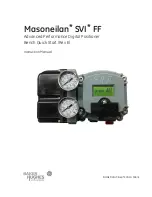
Maintenance and Inspection
As with all precision equipment, it is
necessary to periodically test the posi-
tioner to ensure optimum performance.
We recommend the following proce-
dure once a year.
1. Shut off supply pressure and bleed
down at positioner. Note the set-
tings of the variable orifices and re-
move them from the orifice assem-
bly. Clean them thoroughly and re-
install using new o-rings, being sure
to install each orifice in the same
hole from which it was removed (the
orifice and block have matching
numbers for this purpose). Reset
orifices to original settings. Turn on
supply pressure.
2. Apply a midrange signal to the posi-
tioner. Allow the control valve to be-
come stationary at about 50% of the
range. Close the cylinder block
valves or move the MCV-3 handle to
the manual position. The positioner
is now isolated from the cylinder.
Apply a ± ¼ PSIG signal change.
Observe the response in the output
gauges. The output pressure
should develop differential pressure
equal to at least 20% of the power
gas pressure. If the output pressure
does not show immediate response,
the positioner nozzles may not be
adjusted properly. See the adjust-
ment instructions to calculate the
correct balance pressure. Reduce
the output pressures by turning the
drum in the direction of increasing
numbers.
If the pressures do not respond in the
correct direction when reversing the in-
strument signal change, the unit has
internal friction. Disassemble the unit
and replace all rubber goods.
3. Check the integrity of the balanced
valve seats by increasing the dead
band by 1 full number. When the
cylinder top and bottom gages are
equal to the power gas, the exhaust
port should not exhibit any bleed
gas. If either of these tests fail, then
the positioner is not properly ad-
justed or the unit needs to be reas-
sembled with new rubber goods.
4. Soap test around all diaphragm in-
terfaces, orifice assemblies and
vents. If any leaks are found around
the diaphragms, refer to the assem-
bly instructions for replacement of
all internal rubber parts.
5. Observe the operation of the
gauges. If any gauges are defective,
replace them.
6. Check range and bias. If neces-
sary, readjust per Adjustment Pro-
cedures.
Should problems arise or more infor-
mation is required, call toll free (800)
323-8844 for assistance
HPP-4 Positioner
Maintenance and Inspection
HPP-4
14
September 1999
























